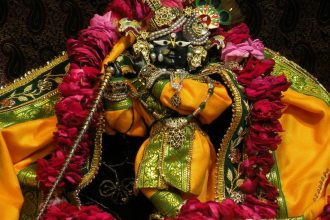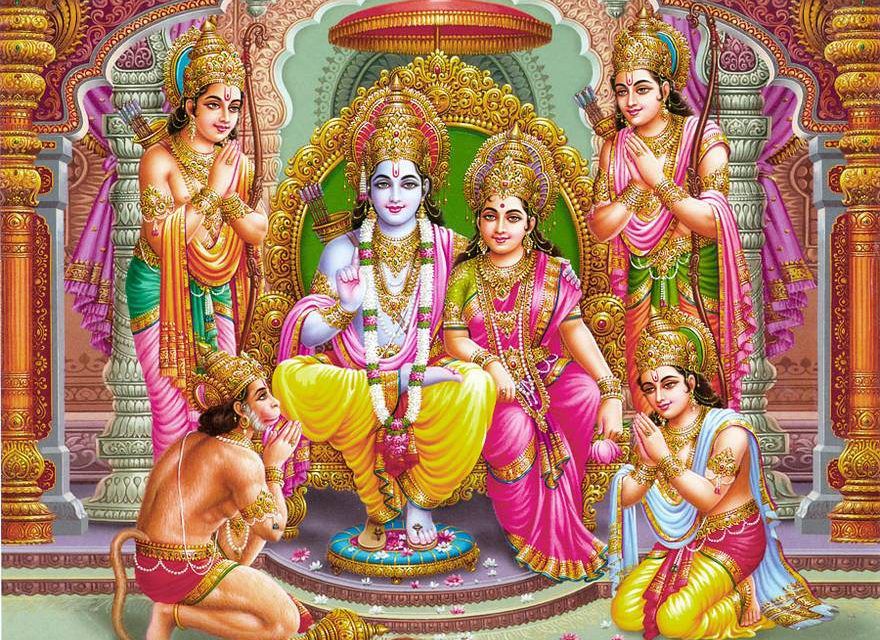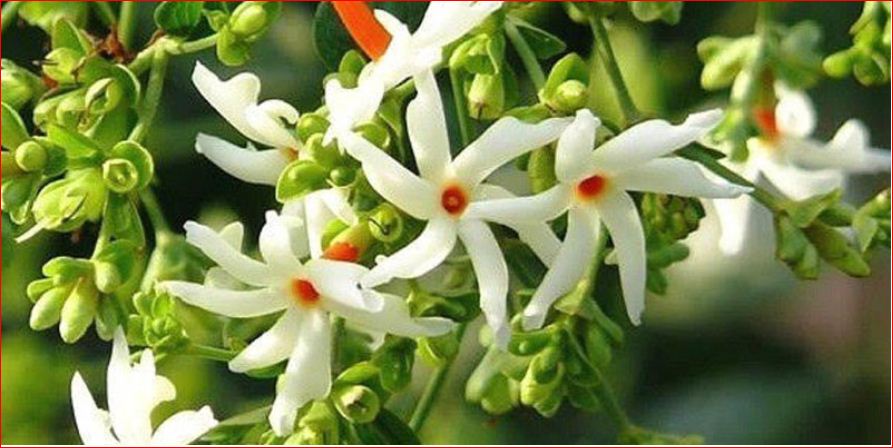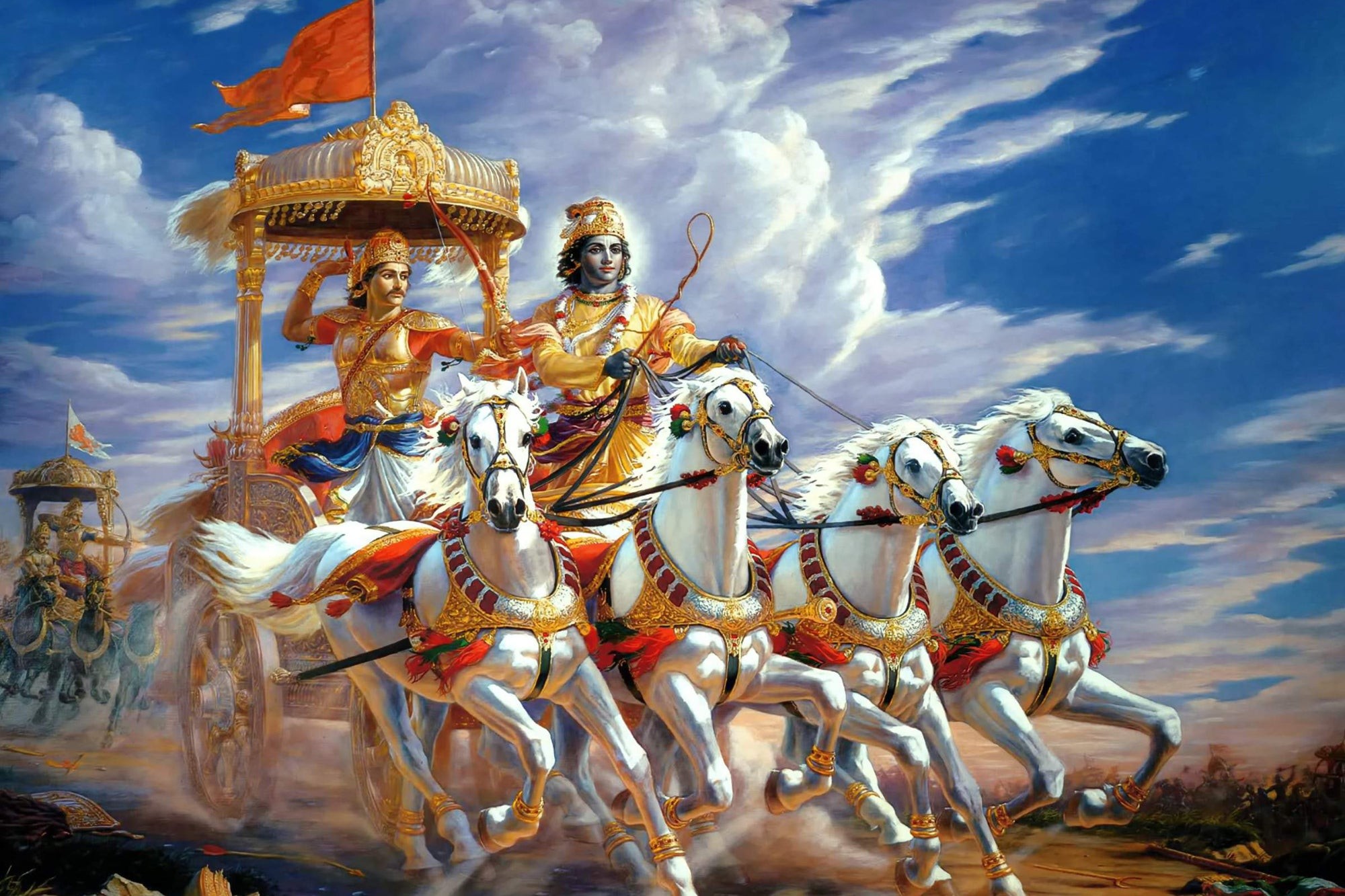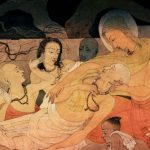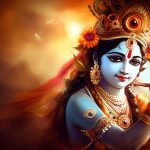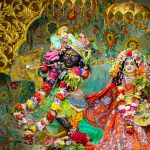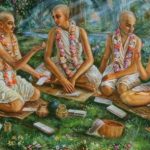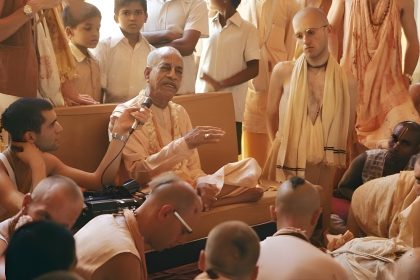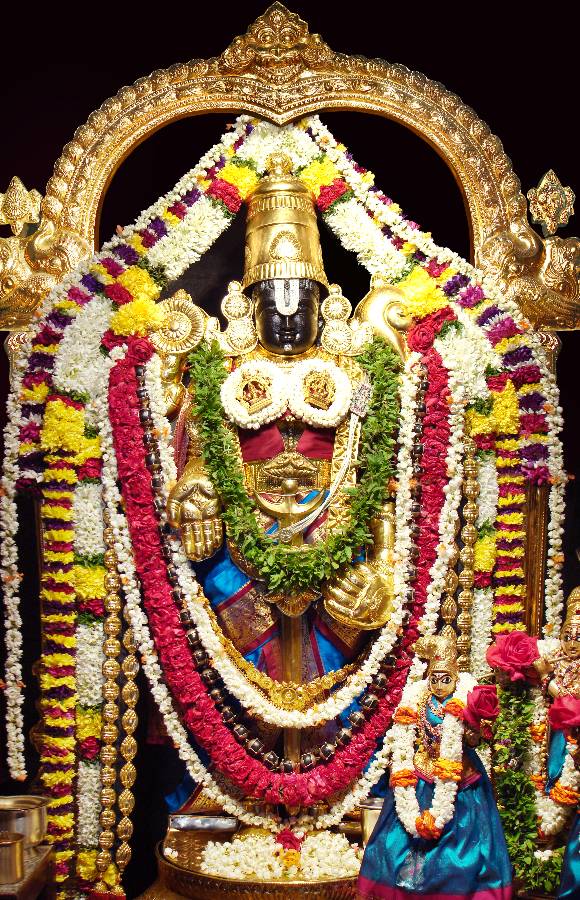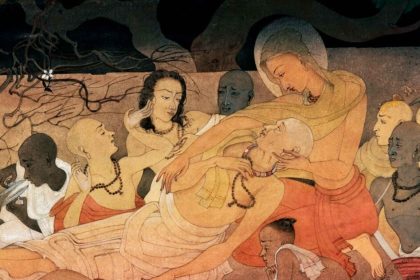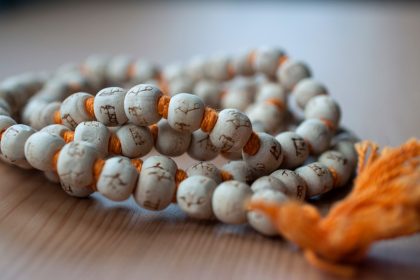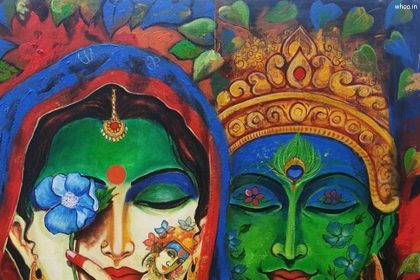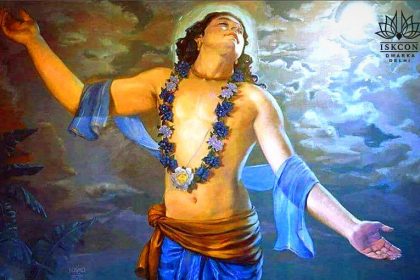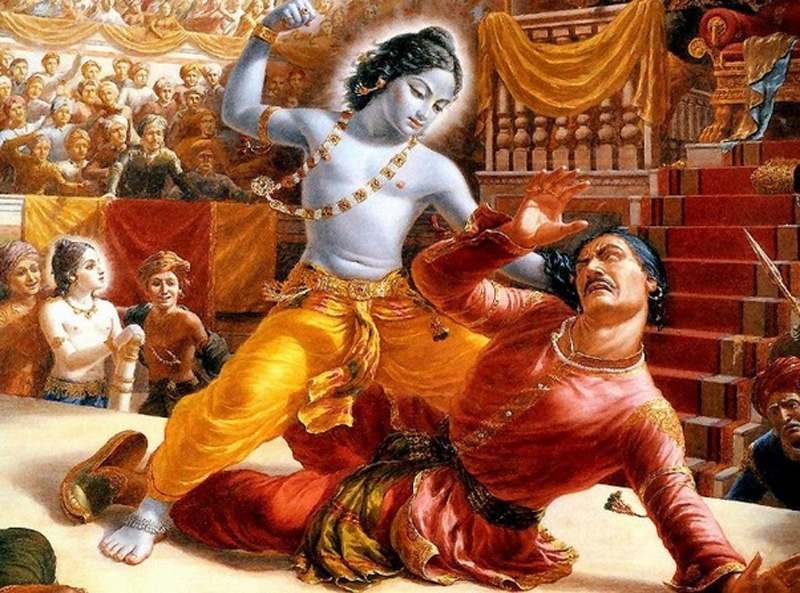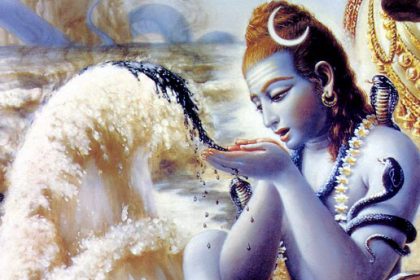A teacher finds a creative way to help her students fix their minds on the Lord.
ON MARCH 18 (in some places, March 17), devotees in the Hare Kṛṣṇa movement, along with millions of other Vaiṣṇavas around the world, will observe one of the most important festivals of the year: Śrī Gaura Pūrṇimā, honoring the appearance of Śrī Caitanya Mahāprabhu. Lord Caitanya, who is Kṛṣṇa Himself in the guise of His own devotee, descended a little over five hundred years ago in the area of West Bengal known as Navadvipa (“Nine Islands”). To our defective vision, Navadvipa may seem like an ordinary place, but pure souls know that Navadvipa, like any place on earth the Lord chooses to call home, is a dhāma—a transcendental site, a replica of His eternal home in the spiritual world. And like the Lord Himself, His dhāma is also worthy of our worship and contemplation.
Last year, Campakalatā Devī Dāsī, a teacher at Padma Academy in Hillsborough, North Carolina, wanted to come up with a school project to help the students absorb their minds in Lord Caitanya for six weeks leading up to the Gaura Pūrṇimā festival. She thought a major art project would work, and one of her students, twelve-year-old Sītārāṇī, suggested dioramas—small three-dimensional scenes of painted molded figures and backgrounds. Campakalatā liked the idea, especially since dioramas are a traditional art form in Bengal. She decided they’d make nine of them, one for each of Navadvipa’s nine islands.
Together, students and teachers decided on one main event per island. Because Navadvipa’s shape resembles that of a lotus, they fashioned eight dioramas on bases shaped like a lotus petal. They shaped the ninth—for Māyāpur, at the center of Navadvipa—like a lotus whorl. They also inscribed a plaque for each diorama, explaining the event depicted.
Each student took responsibility for at least one figure, and some older students made a whole petal. The youngest children made a bed and flower bushes. As they completed the project, the students were amazed they could make realistic figures, and they were gratified that through their humble efforts, Lord Caitanya and His devotees had revealed themselves.
Padma Academy teaches boys and girls ages 5–18 and awards recognized American high school diplomas. Contact Māyāpurcandra Dāsa, principal (mayapur @com.org), Campakalatā Devī Dāsī, teacher (campaka @com.org), or Ṇrmilā Devī Dāsī, teacher (urmila@com.org; or call (919) 643-2001. Or visit www.radharani.com.

Antardvipa | The Birthplace of Lord Caitanya
This island is also called Māyāpur and is the birthplace of Lord Caitanya. At the time of Lord Caitanya’s birth, there was a lunar eclipse. To ward off its inauspicious effects, all the people of Navadvipa (or Nadia, as it was called at that time) bathed in the holy Ganges and chanted the names of Kṛṣṇa. Lord Caitanya, who had remained in His mother’s womb for 13 months, chose this auspicious time, while everyone was chanting His name, to appear. Although He would later be named Viśvambara and eventually be called Lord Caitanya, His mother, Śacī, affectionately called her beautiful golden son Nimāi, after the neem tree beneath which He was born.
—Made by Dhaniṣṭhā
Rudradvipa | Lord Caitanya Takes Sannyāsa
In Rudradvipa there is a place named Nirdaya, which means “merciless.” While His devoted wife, Viṣṇupriyā, slept, Lord Caitanya left His home in Antaradvipa to take sannyāsa. He traveled to the west and crossed the Ganges River to this village in Rudradvipa. Though His purpose in taking sannyāsa was to deliver all the fallen souls, the act appeared merciless, hence the name “Nirdaya.”
—Made by Rādhikā, Campakalatā, and Balarāma
Godrumadvipa | Nimāi Grows a Mango Tree
Once, the Lord was performing saṇkīrtana with His devotees. After chanting and dancing for a long time, they became tired and sat down to rest. Seeing how tired they were, the Lord took a mango seed and planted it in the ground. The minute it was planted, the seed sprouted and began to grow. As the astonished devotees looked on, the full-grown tree soon hung heavy with hundreds of mangos. These mangos had no seeds inside and no skins outside. They were so sweet, and filled with so much juice, that after eating only one each, the devotees were completely satisfied.
—Made by Campakalatā and Jahnu
Modadrumadvipa | Sāraṇga Ṭhākura Initiates a Dead Boy
There was a devotee during Lord Caitanya’s time named Sāraṇga Thākura. Lord Caitanya was very pleased with Sāraṇga’s devotion and asked him to make some disciples. Sāraṇga assured the Lord that the next day he would initiate the first person he saw. The next morning, as he was about to step into the Ganges to bathe, he saw a boy’s dead body float past. Remembering his promise to Lord Caitanya, he brought the dead boy’s body to the shore and chanted the initiating mantras into his ear. As soon as the dead boy heard the mantras, he came back to life.
He offered his obeisances to the feet of Sāraṇga and told him, “Yesterday I was undergoing a ceremony to accept initiation, but a black snake came and bit me. I can’t remember anything after that.”
—Made by Cintāmaṇi
Koladvipa | Jagannātha Dāsa Bābājī Dances
Jagannātha Dāsa Bābājī’s samādhi [memorial tomb] is located here. This great ācārya in the Gauḍiyā Vaiṣṇava line lived over 150 years ago. He was regarded as the chief of the Vaiṣṇavas of his time. In 1893, when he was 142 years old, he went with Bhaktivinoda Thākura to try to find the real birthplace of Lord Caitanya. He was so old that he could not walk and his body was stooped over. His eyelids drooped so much that if he wanted to see something, his disciples would have to hold his eyelids open. He was able to travel to the holy places of Navadvipa in a basket his disciples carried on their heads. Despite his decrepit condition, when he reached the spot where Lord Caitanya was born (in Antardvipa) he jumped out of his basket and danced in ecstasy.
—Made by Śacī and Pārijāta
Ritudvipa | Nitāi Falls Unconscious
Once Lord Nityānanda, along with His associates, entered the wonderful forests of Ritudvipa. The beauty of the forests reminded the Lord of His intimate pastimes with Kṛṣṇa as Kṛṣṇa’s older brother, Balarāma.
In the mood of Balarāma, Lord Nityānanda called out, “Quickly bring Me My horn! My cowherd friends are far ahead of Me. Kṛṣṇa is fast asleep and won’t get up. I can’t herd these cows alone.”
The devotees with Him tried to calm Him. They reminded Him who He actually was.
They said, “O Nityānanda Prabhu, Your brother, Lord Caitanya, has gone and taken sannyāsa, leaving us here alone.”
Lord Nityānanda became so heartbroken at hearing this that He lost consciousness.
—Made by Kundalatā, Dhaniṣṭhā, and Campakalatā
Jahnudvipa | Jahnu Muni Releases Ganga
Near Kapila’s ashram, on this island of Jahnudvipa, a great sage named Jāhnu once had his ashram. One day while sitting in meditation, he heard the deafening roar of the Ganges River as she followed the sage Bhagīratha. Afraid that Ganga would destroy the planet, Jahnu Muni swallowed her up in one gulp. Bhagīratha was overcome with anxiety. Ganga was supposed to liberate his ancestors! With great devotion, he worshiped Jahnu Muni, offering beautiful prayers. Pleased with Bhagīratha’s sincerity, Jahnu Muni allowed Ganga to emerge from his ear. Thus, Ganga is known as Jāhnavī Devī, the daughter of Jahnu Muni.
—Made by Sītārāṇī, Lalitā, and Campakalatā
Madhyadvipa | Lord Śiva Rides Brahmā’s Swan
On this island there is a forest called Naimisharanya, where at the beginning of Kali-yuga thirty-three thousand sages assembled to hear the Śrīmad-Bhāgavatam spoken by Śrīla Sūta Gosvāmī. Lord Śiva, who was also eager to hear this narration, mounted His bull carrier, Nandi, and left His abode on Mount Kailasa. However, He feared that the recitation would end before His arrival because Nandi was too slow. So He abandoned Nandi and mounted Brahmā’s swift swan carrier, who brought Him to Naimisharanya just in time.
—Made by Ānanda


